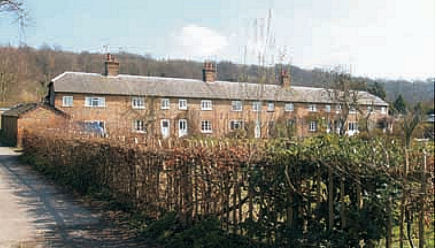|
|
Barrack Row. Aldbury, 19th cemtury December, 2011 |
|
Rita Fretwell (ritafretwell @t btinternet.com) of Norwich, Norfolk, writes: I used to live in Aldbury many years ago and a friend of mine who lives in Pitstone has asked me why the 'Barrack Row' on Stocks Road is so called. Could not find anything on the internet, thought perhaps you could help.
The origins of Barrack Row is described in the Aldbury Conservation Area Character Appraisal (pdf) report which includes a modern picture of the cottages

and the following statement:
In the opening years of the C19th, estate influences in the village began to shift from Stocks to Ashridge, (east of the Conservation area); the 7th Earl of Bridgewater remodelled the main house and then as Lord of the Manor, began to stamp his mark on the village; particularly around the church and green – the old manorial and Chantry Farm sites were redeveloped as Church Farm; cottages were demolished and rebuilt; Ebelthite's Farm was replaced with a striking terrace of eight cottages ('Barrack Row'). These reflected two trends: the influence of the new Grand Junction Canal (in the south-west corner of the parish), which brought the first slates to the village (it was then called 'Slated Row') and the need to accommodate a rapidly increasing population.
The book Aldbury, the Open Village goes into more detail in describing the cottages:
North of the pond, the Ebelthite farmhouse was being replaced. Instead of the old barns and stables, a row of eight cottages was erected in upper High Street, well back from the road. Neither tile nor thatch, both of which were available locally, was used for the roof: the novelty of the imported material, certainly brought by canal like that used for the roof at Church Farm House, was reflected in the local name for the cottages - Slated Row. Each cottage had one front and two small back rooms with a hall passage and stairs, beneath which was a useful cupboard. Upstairs there were two bedrooms and the general appearance was neat and cheerful. By 1830, the rent of each was to be £3.10.0 a year.
and later:
Each of the slated cottages had the use of a "barn" which, in village parlance, meant a small rough timber building, probably thatched, for storing fuel and old lumber. There were also the privies. In a long letter to be sent to the Ashridge agent, Robert Clarke, in 1831 after William Buckingham's death, Mrs Gordon of Stocks was to comment on the hygiene at the cottages. This was a point on which the late Earl and his officers had prided themselves, and the remarks were not well received.
"... Mrs Gordon is also sorry to find that there are not four more Necessaries built to each of the two Rows of 8 Tenements that are provided with only 4, they being the most certain spread of infection, and reminds Mr Clarke there is no back door nor actual back Window below to any Tenements in those Rows, therefore no possibility of a real free Ventilation ... the side window of the third room which is by all used as an adjunct Bed Room instead of what is ought to be a Wash-house, etc .... If such Necessaries are deemed disfiguring to look down on from the Hill they might, as at Lord Tavistocks at Oakley, be made to appear as a Stack of Wood bearing each a different shape ... "
Mr Clarke had pleasure in informing Mrs Gordon that two dumb wells each 24ft deep, arched over and covered with earth, had been made, "these being immediately adjoining, will receive into their depth everything that falls ... there can be no contagion." Also, he knew from experience that it was impossible to get country people to open the back and front windows for ventilation in the daytime, either farmers or cottagers.
Finally a note adds:
Slated Row is now known as Barrack Row, perhaps from the iron railings which enclosed the front gardens until translated into munitions during the [2nd World] war.
I am not clear why the iron railings would cause the cottages to be called Barrack Row - but the cottages are very different to other older workmen's accommodation and perhaps the place was deemed to be like an army barracks. They are already described as Barrack Row in the 1871 census, and may have been known by this name even earlier. However Jean Davis, who wrote the book, was a careful historian who looked at the most relevant historical records, and if there was a better explanation I am sure she would have found and recorded it.

